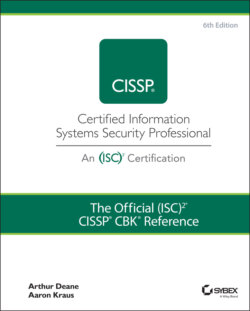Читать книгу The Official (ISC)2 CISSP CBK Reference - Leslie Fife, Aaron Kraus - Страница 12
Introduction
ОглавлениеTHE CERTIFIED INFORMATION SYSTEMS Security Professional (CISSP) certification identifies a professional who has demonstrated skills, knowledge, and abilities across a wide array of security practices and principles. The exam covers eight domains of practice, which are codified in the CISSP Common Body of Knowledge (CBK). The CBK presents topics that a CISSP can use in their daily role to identify and manage security risks to data and information systems and is built on a foundation comprising fundamental security concepts of confidentiality, integrity, availability, nonrepudiation, and authenticity (CIANA), as well as privacy and security (CIANA+PS). A variety of controls can be implemented for both data and systems, with the goal of either safeguarding or mitigating security risks to each of these foundational principles.
Global professionals take many paths into information security, and each candidate's experience must be combined with variations in practice and perspective across industries and regions due to the global reach of the certification. For most security practitioners, achieving CISSP requires study and learning new disciplines, and professionals are unlikely to work across all eight domains on a daily basis. The CISSP CBK is a baseline standard of security knowledge to help security practitioners deal with new and evolving risks, and this guide provides easy reference to aid practitioners in applying security topics and principles. This baseline must be connected with the reader's own experience and the unique operating environment of the reader's organization to be effective. The rapid pace of change in security also demands that practitioners continuously maintain their knowledge, so CISSP credential holders are also expected to maintain their knowledge via continuing education. Reference materials like this guide, along with other content sources such as industry conferences, webinars, and research are vital to maintaining this knowledge.
The domains presented in the CBK are progressive, starting with a foundation of basic security and risk management concepts in Chapter 1, “Security and Risk Management,” as well as fundamental topics of identifying, valuing, and applying proper risk mitigations for asset security in Chapter 2,“Asset Security.” Applying security to complex technology environments can be achieved by applying architecture and engineering concepts, which are presented in Chapter 3, “Security Architecture and Engineering.” Chapter 4, “Communication and Network Security,” details both the critical risks to as well as the critical defensive role played by communications networks, and Chapter 5, “Identity and Access Management,” covers the crucial practices of identifying users (both human and nonhuman) and controlling their access to systems, data, and other resources. Once a security program is designed, it is vital to gather information about and assess its effectiveness, which is covered in Chapter 6, “Security Assessment and Testing,” and keep the entire affair running — also known as security operations or SecOps, which is covered in Chapter 7, “Security Operations.” Finally, the vital role played by software is addressed in Chapter 8, “Software Development Security,” which covers both principles of securely developing software as well as risks and threats to software and development environments. The following presents overviews for each of these chapters in a little more detail.
